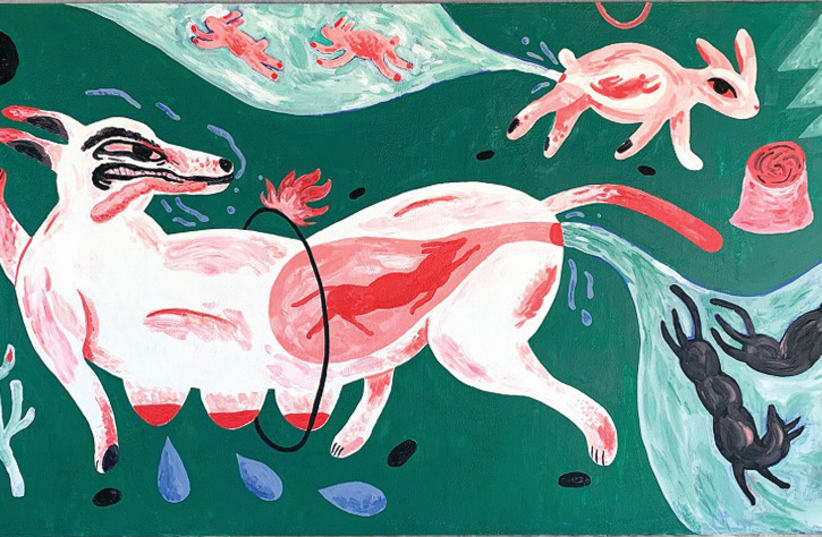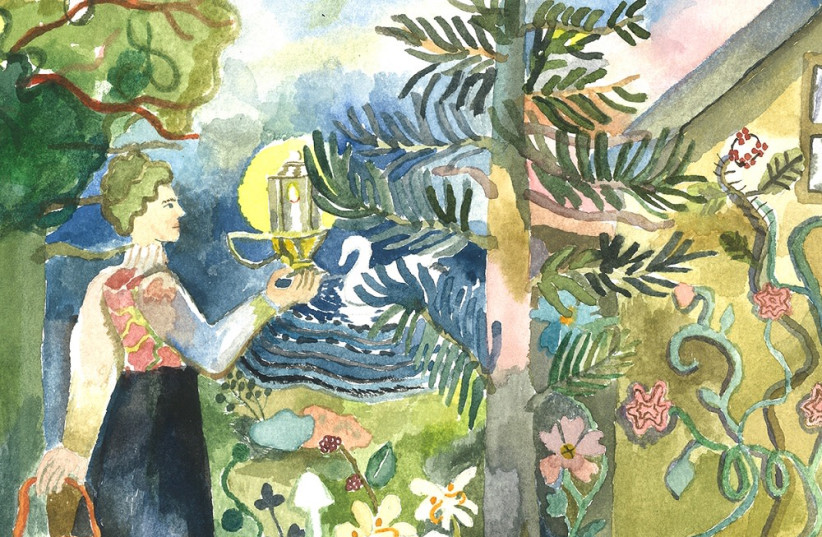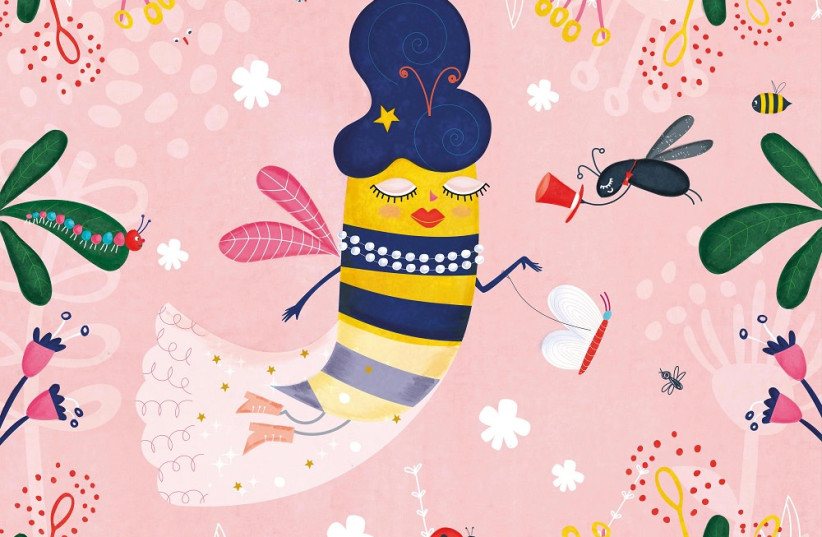Yuval Saar would, no doubt, be happy to join in the merry sing-along at the end of Monty Python’s delightfully impious Life of Brian movie. You could imagine the graphic designer, curator and educator humming along as the happy-go-lucky crucified bunch sing the farcically cheery Always Look on the Bright Side of Life number in the closing scene.
That sunny life philosophy shines through much of the expansive program of events and exhibitions Saar has lined up for the eighth edition of Illustration Week, taking place in Tel Aviv-Jaffa on November 18-27.
The perennial artistic director claims that there is nothing premeditated about the programmatic positivity, rather he is just feeding off a ground swell of feel-good vibes. “Each year we send out a call for submissions. We don’t specify a theme, we don’t tell people what to do. All we say to them is ‘bring good new works.’”
The display output is, Saar says, just a product of the lay of the emotional mindset land. “Each year, in some sense, you can see the zeitgeist because the artists’ work reflects what engages them at the time. In that respect the sense of optimism comes from the improvement in the general feeling, certainly compared with this time last year. You can clearly see some light at the end of the tunnel.” That’s nice to hear, and should make the viewing experience that much more pleasurable.
And there will be plenty to view. The 10-day event incorporates the work of 700 illustrators spread across 76 exhibitions in cultural institutions, cooperative galleries, museums and leisure centers and at outdoor public hubs across the city.
Saar says the festival backers also want to spread the good word, as far and wide as possible. “The municipality focused particularly on the south and east of Tel Aviv and Jaffa. They attach great importance to disseminating culture right across the city, in all sectors of the public, by having institutions and festivals in all areas, and spreading the resources around. I think they don’t want to have exhibitions just in downtown Tel Aviv, and on Rothschild Boulevard. They want to have events in places that generally don’t have many things like this.” Indeed, if you’ve got it why not share it?
The geographic dispersal also dictated some of the thematic choices whereby artists were asked to try to connect with the locale in which their works were due to be displayed. “When we put out the call for proposals we asked artists to try to relate to the areas in question – the south and east of Tel Aviv, and Jaffa – in terms of the content,” Saar explains, adding that the neighborhood-specific approach yielded some intriguing results. Mind you, not all the curators were faithful to the home base ethos. “For example, there is an exhibition at Teder, which is called Imma Tachanah (Station Mom), which references the Tel Aviv central bus station, but which is displayed somewhere else,” Saar notes. Teder is located at Romano House, not that far away from the bus station but not exactly adjacent to the hulking and not overly beloved public transport facility.
The loose relationship with specifics is, he says, a feature that runs through the thinking behind the project, and the creative bottom line. “The work includes illustration, sculpture and screenings and an installation. They blur the lines between mediums and also get into urban legends. You can’t really know what comes from a legend and what really happens.”
The contributing artists are all recent graduates of the Visual Communication Department of Jerusalem’s Bezalel Academy of Arts and Design, who collaborate on various projects as the envelope-pushing Tama Collective. The artists, under the seasoned guiding hand of internationally acclaimed artist, illustrator, comic book artist, performer, activist and lecturer Zeev Engelmayer, worked on the premise that the Tel Aviv Bus Station is a sort of local Bermuda Triangle in which perception of the boundary between urban legends and the light-of-day truth is up for grabs. Paradoxically, it seems the unfastidious take yielded rich and illuminating results. “As with the depths of the sea, with the station the deeper they dive into the dark recesses they reveal hidden layers of life, and discover that in every fable there is an unexpected grain of truth,” the festival text notes. “In the atmospheric installation, the members of the collective bring out real life that exists at the station, here and now.”
Following Saar’s buoyant handle on life about him it is not difficult to figure out how an exhibition called Good Words slots into his philosophic purview. The spread, at the Jaffa Museum, curated by Tom Cohen from the Shenkar Institute’s Center for Research and Documentation of Design in Israel, comprises a collection of past and new works that proffer messages of hope, solidarity, compassion and optimism across a bunch of posters that convey positivity and emotional succor. Some of the exhibits come from the center’s vaults, including some smile-inducing stuff from late Jerusalem Post cartoonist Dosh, while others were created for the Jaffa Museum event by 16 designers who were asked to produce new posters that impart messages of a better viewpoint – realistic or imagined. As Cohen notes: “The exhibition presents a picture of optimism and hope that comes out of the complex domain in which we live.” We could all do with some of that.
And while we’re on the subject of rose-tinted specs and positive intent, the “Illustrating a Future Without Disease” exhibition at the southern Tel Aviv premises of the Venn Tel Aviv urban-tech start-up, which offers solutions for personal dislocation and loneliness in cities, hits home just where the heart is. The show, which is sponsored by early education specialists Early Starters International and Nala Ltd. PBC, which sets out to achieve “a world free of curable diseases that perpetuate poverty,” features works by 16 illustrators from Israel and Ethiopia gleaned from projects that address the treatment and prevention of neglected tropical diseases. As new wave rocker Ian Dury noted in 1979, there appear to be plenty of reasons to be cheerful.
NATURALLY, IN this post-coronavirus time of ours, the topic of domiciles and what constitutes a genuine domicile makes an appearance or two across the almost threescore and ten exhibition roster. The intriguingly truncated moniker of the Home Is Only show, at 9 Kikar Kedumim in Old Jaffa, curated by Reut Barnea, looks into the concept of home, and what it means to us. “A square, generally white, with a triangle on top, usually red,” notes the exhibition blurb “is an image which mostly does not indicate the real home. Nevertheless it is there, a schematic image which plays on so many heartstrings, and reflects values and a life philosophy.”
This is a slot which should evoke emotion and, no doubt, a powerful sense of nostalgia. Works by 10 professional artists will be displayed alongside a series of drawings by children under the age of 10 living around the country. The thematic core relates to the meaning of the concept of the home, and how it connects to the primordial childlike image of a small house with a red roof.” That also offers ecological food for thought in a country where flat white roofs would make much more sense.
Notwithstanding the festival’s stated local emphasis, there is some more offshore content in the NRW at Illustration Week, an exhibition at 15 Mazal Dagim Alley in Old Jaffa. The acronym in question, in full, spells out the name of the western German state of North Rhine-Westphalia. The show is sponsored by the state’s Israeli branch of the Chamber of Economics, Science, Education, Youth and Culture and the Goethe Institute, and features works and the process of their creation by four children’s books illustrators and writers, from the German state. The exhibition provides a glimpse of the arts scene in North Rhine-Westphalia and, for Saar, is an opportunity for a bit of hands-across-the-water collaboration. “We mostly highlight our local scene, because we strongly believe in it and also because of the corona fallout. But this is the second year that North Rhine-Westphalia has participated in Illustration Week, and I think presenting works from abroad is a wonderful way to generate cultural ties and to gain inspiration from other places.”
Jaffa Museum also hosts the large scale Rose Period exhibition, curated by Einav Weissman and Yuli Peretz Calatchi, with illustrations by 33 artists referencing the eponymous early stage in Pablo Picasso’s professional evolution. It was a time when the twenty-something Spaniard was awash with insouciant glee. It is, Saar notes, part of a colorful continuum. “We had an exhibition, two years ago, based on Picasso’s Blue Period. Pink is very optimistic,” he chuckles, “and the works are amazing.”
Homo Flora, which is also in the Jaffa Museum’s festival layout, sponsored by the Little Big, a science nonprofit, is a compelling investigation of the similarities and contrasts between the reproductive systems of plant life and humans. Noa Ilan produced two series of illustrations, one of which looks at a range of reproductive systems, while the other speculates whether the reproductive systems of flora could possibly suit human needs.
In this Covid-constrained era we could all do with some sense of security, as could our offspring. That acute issue is given an airing at the 68 Girls and Boys – an illustrated monument exhibition at the Social Space facility on Allenby Street in Tel Aviv. The show, curated by Or Segal, comprises dozens of works created by artists in the wake of the IDF’s Guardian of the Walls operation in May. The exhibition is dedicated to the memory of children killed in Israel and Gaza, and was inspired by a social media project during the course of the operation, which called on people not to accept the status quo but to work for change.
Saar hopes that message comes across, and that the festival brings some light and merriment to our lives, and offers no apologies for his sunny demeanor. “Illustration Week offers us an opportunity to go around the city and enjoy some great exhibitions. There is something so communicative in the work of illustrators. You can just walk around town and go wow!”
With 76 exhibitions, and a bunch of arts-based guided tours, on offer we may all, indeed, end up with smiles on our faces.
For more information: illustrationweek.co.il


